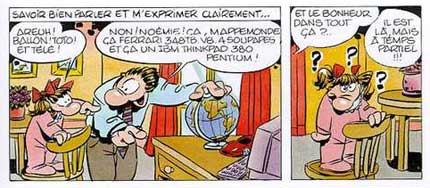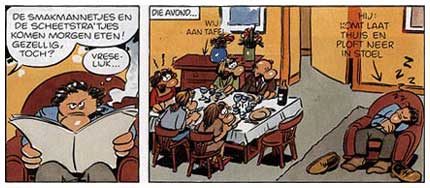Florence Cestac did artistic studies in both Rouen and Paris. She co-founded Bonbel, an artist collective in Rouen, and worked for the press group Filipacchi. With Etienne Robial and Denis Ozanne, she opened the bookstore Futuropolis in 1972, and participated two years later in founding the publishing company with the same name. In the same period, she created the comic character 'Harry Mickson', who became Futuropolis' emblem and mascot, and pursued a career in comics in L'Écho des Savanes from 1976.
In addition, Cestac occasionally contributed to Ah Nana!, Métal Hurlant, Charlie Mensuel, Viper, Pilote and Chic. From 1980, she was present in À Suivre, and starting two years later, also in Charlie Mensuel. The core of Cestac's output was collected in albums by Futuropolis from 1979, such as 'Cauchemar Matinal', 'Les Vieux Copains plein de Pépins', and 'Comment Faire de la Bédé, Sans Passer Pour un Pied-Nickelés'.
In 1989, Cestac created 'Gérard Crétin' in Mikado, and succeeded Sophie Hérout on 'Les Déblok' in Le Journal de Mickey. Furthermore, she illustrated children's books at the publishing house Nathan, and cooperated with Syros and Albin Michel. For the latter, she cooperated with Marie-Ange Guillaume and Dodo on 'J'Attends un Chien' and 'Je Veux pas Divorcer', and with Dodo, Édith and Nathalie Roques on 'Quatre Punaises au Club'. For Dargaud, she made 'Le Démon de Midi', which won the Alph'Art for best Humorous Album in Angoulême in 1997, and which was also adapted into a theater play.
While working extensively for the juvenile market, her more adult work was published in the collection 'Cestac pour les Grands' at Dargaud. In 2001, she began her own booklet, called Cestac Color, which featured the works of Charlie Schlingo, Philippe Vuillemin, Frank Margerin, René Pétillon, Jano, Max and Jean-Claude Denis. In 2004, she created 'Super Catho' with Pétillon at Dargaud.
She was one of several artists to make a graphic contribution to ‘Pepperland’ (1980), a collective comic book tribute to the store Pepperland, to celebrate its 10th anniversary at the time. In 1983, he was one of many comic artists paying homage to the recently deceased Hergé in a special issue of (À Suivre), titled 'Adieu Hergé'. He additionally made a graphic contribution to the anti-racism collective comic book 'Rire Contre Le Racisme' (Jungle!, 2006).




